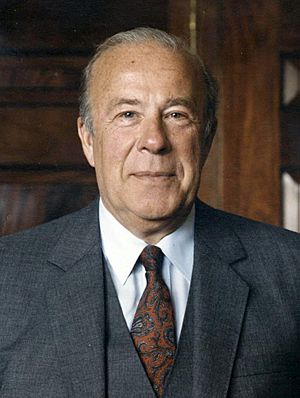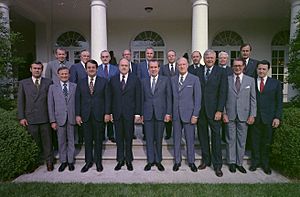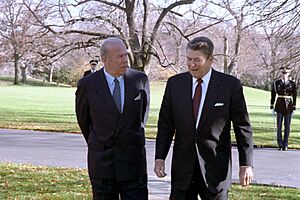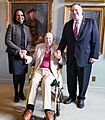George Shultz facts for kids
Quick facts for kids
George Shultz
|
|
|---|---|

Shultz in the 1980s
|
|
| 60th United States Secretary of State | |
| In office July 16, 1982 – January 20, 1989 |
|
| President | Ronald Reagan |
| Deputy |
|
| Preceded by | Alexander Haig |
| Succeeded by | James Baker |
| 62nd United States Secretary of the Treasury | |
| In office June 12, 1972 – May 8, 1974 |
|
| President | Richard Nixon |
| Preceded by | John Connally |
| Succeeded by | William E. Simon |
| 19th Director of the Office of Management and Budget | |
| In office July 1, 1970 – June 11, 1972 |
|
| President | Richard Nixon |
| Preceded by | Bob Mayo (Bureau of the Budget) |
| Succeeded by | Caspar Weinberger |
| 11th United States Secretary of Labor | |
| In office January 22, 1969 – July 1, 1970 |
|
| President | Richard Nixon |
| Preceded by | W. Willard Wirtz |
| Succeeded by | James Day Hodgson |
| Personal details | |
| Born |
George Pratt Shultz
December 13, 1920 New York City, U.S. |
| Died | February 6, 2021 (aged 100) Stanford, California, U.S. |
| Resting place | Dawes Cemetery, Cummington, Massachusetts, U.S. |
| Political party | Republican |
| Spouses |
|
| Children | 5 |
| Education | |
| Awards | Presidential Medal of Freedom (1989) |
| Signature | |
| Military service | |
| Branch/service | United States Marine Corps |
| Years of service | 1942–1945 |
| Rank | Captain |
| Battles/wars |
|
George Pratt Shultz (born December 13, 1920 – died February 6, 2021) was an important American economist, businessman, and diplomat. He worked for two different Republican presidents. He was one of only two people to hold four different top government jobs, called Cabinet positions.
Shultz played a big part in shaping the foreign policy of President Ronald Reagan. Before that, he was a leader at Bechtel Group, a large engineering company. He was born in New York City and served in the United States Marine Corps during World War II. After the war, he earned a PhD in economics. He taught at MIT and the University of Chicago.
Contents
Early Life and Education
George Shultz was born on December 13, 1920, in New York City. He was the only child of Margaret and Birl Shultz. He grew up in Englewood, New Jersey. His family came from Germany in the mid-1800s. He was not related to the famous Pratt family known for Standard Oil.
He went to local public schools and then to the Englewood School for Boys. In 1938, he graduated from Loomis Chaffee School. He then studied economics at Princeton University and graduated with honors in 1942. His senior paper was about the Tennessee Valley Authority's effect on farming.
From 1942 to 1945, Shultz served in the U.S. Marine Corps as an artillery officer. He reached the rank of captain. He fought in the Battle of Angaur during World War II.
In 1949, Shultz earned his PhD in industrial economics from the Massachusetts Institute of Technology (MIT). Industrial economics looks at how industries and businesses work. He taught at MIT from 1948 to 1957. During this time, he also worked for President Dwight D. Eisenhower's Council of Economic Advisers. This group gives economic advice to the president.
In 1957, Shultz became a professor at the University of Chicago Graduate School of Business. He was the dean of the school from 1962 to 1968. While there, he was influenced by famous economists Milton Friedman and George Stigler. They taught him about the importance of a free-market economy, where prices are set by supply and demand, not by the government.
Working for President Nixon

George Shultz held several important jobs under President Richard Nixon.
Secretary of Labor
Shultz was President Nixon's Secretary of Labor from 1969 to 1970. This job involves looking after workers' rights and conditions. He faced a big strike by the Longshoremen's Union. He let the workers and companies work out their problems, which they did quickly.
He also introduced the Philadelphia Plan. This plan required construction companies in Pennsylvania to hire a certain number of Black workers. This was a new step by the government to fight against unfair hiring practices.
Director of the Office of Management and Budget
In 1970, Shultz became the first director of the Office of Management and Budget (OMB). This office helps the president manage the government's budget and spending.
Secretary of the Treasury
Shultz was the United States Secretary of the Treasury from 1972 to 1974. This role involves managing the country's money and economy. He helped with Nixon's "New Economic Policy," which aimed to improve the economy.
He also dealt with a major change in how money worked around the world. In 1973, he helped end the Bretton Woods system. This system had tied the value of the U.S. dollar to gold. After this, currencies around the world could "float," meaning their value could change more freely based on the market. Shultz also helped create the "Library Group," which later became the G7, a group of leading industrial countries.
Working in Business
In 1974, Shultz left government work. He became an executive at Bechtel Group, a very large engineering and construction company. He later became its president. Under his leadership, Bechtel won many big contracts, including some in Saudi Arabia.
Working for President Reagan
Shultz is one of only two people to have served in four different top government positions in the U.S. Cabinet.
Secretary of State
On July 16, 1982, President Ronald Reagan chose George Shultz to be the 60th U.S. Secretary of State. This is the top diplomat for the United States, dealing with other countries. Shultz served for six and a half years, which was a long time for this job.
Shultz worked closely with the Foreign Service, which is made up of professional diplomats. He had a strong relationship with President Reagan, who trusted him a lot.
Relations with China
Shultz continued talks with China about Taiwan. The U.S. had promised to help Taiwan defend itself, which included selling weapons. After many talks, the U.S. and China agreed in 1982 that the U.S. would limit arms sales to Taiwan, and China would seek a peaceful solution.
Relations with Europe and the Soviet Union
During Shultz's time, relations between the U.S. and the Soviet Union were tense. He helped solve a problem with European countries about a pipeline to the Soviet Union. The U.S. had put sanctions (penalties) on it, but European countries felt it hurt them. Shultz helped find a solution where the U.S. removed sanctions, and Europe agreed to control trade with the Soviets more strictly.
Another big issue was nuclear missiles in Europe. Shultz worked to keep the U.S. and its allies united. Despite protests, new missiles were placed in Europe in 1983 to counter Soviet missiles.
When Mikhail Gorbachev became the leader of the Soviet Union in 1985, Shultz encouraged Reagan to talk with him directly. This led to a "thaw" or warming of relations between the two superpowers. In 1987, they signed the Intermediate Range Nuclear Forces Treaty, which removed a whole class of missiles from Europe. This was a very important step in ending the Cold War.
Shultz believed that the Soviet Union was changing. He saw this when the Soviets started to withdraw their troops from Afghanistan. He also noted Gorbachev's plans for major changes within the Soviet Union, like competitive elections and more freedoms.
Middle East Diplomacy
Shultz was involved in efforts to bring peace to the Middle East. He helped negotiate an agreement between Israel and Lebanon. He also worked to start talks with the Palestine Liberation Organization (PLO), a group representing Palestinians.
Latin America
Shultz was strongly against the "arms for hostages" scandal, which became known as the Iran-Contra Affair. This was when the U.S. secretly sold weapons to Iran in exchange for American hostages, and then used the money to fund the Contras in Nicaragua. Shultz believed this was wrong and spoke out against it. He thought the Sandinista government in Nicaragua was a problem, but he did not support illegal ways to fight them.
Later Life and Activities

After leaving government, George Shultz remained active in public life. He often shared his opinions, even if they differed from other Republicans.
He was an early supporter of George W. Bush for president. He advised Bush's campaign and later his administration on foreign policy. Shultz supported the 2003 invasion of Iraq.
Shultz also spoke out against the U.S. trade ban on Cuba, saying it was "ridiculous" after the Cold War ended. He believed that talking with Cuba was a better approach.
In his later years, Shultz became a strong supporter of nuclear arms control. He believed that nuclear weapons were too dangerous to use and that the world would be safer without them. He worked with other former leaders like Henry Kissinger to promote a world free of nuclear weapons.
Shultz was also a strong advocate for fighting climate change. He supported a "carbon tax," which would tax carbon emissions and give the money back to taxpayers. He believed this was the best way to reduce pollution and help the environment. He joined groups like the Citizens' Climate Lobby and the Climate Leadership Council to promote these ideas.
Shultz was a distinguished fellow at the Hoover Institution at Stanford University. He also served on the boards of several companies and organizations. He was on the board of Theranos, a company that later faced problems for misleading investors. His grandson, Tyler Shultz, became a whistleblower about the company's issues.
Family Life
While serving in the Marines during World War II, George Shultz met Helena Maria O'Brien, a military nurse. They married in 1946 and had five children: Margaret, Kathleen, Peter, Barbara, and Alexander. Helena passed away in 1995.
In 1997, Shultz married Charlotte Mailliard Swig, a well-known philanthropist. They were married until his death.
Death
George Shultz died at his home in Stanford, California, on February 6, 2021, at the age of 100. He was buried in Cummington, Massachusetts.
President Joe Biden praised Shultz, calling him "a gentleman of honor and ideas." Biden said Shultz was dedicated to public service and respectful discussions.
Honors and Awards
George Shultz received many awards and honors throughout his life for his public service and contributions.
- 2016 – Presidential Medal of Honor
- 2014 – Honorary Reagan Fellow Award
- 2012 – Henry A. Kissinger Prize
- 2011 – Honorary Officer of the Order of Australia
- 2010 – California Hall of Fame
- 2008 – Rumford Prize
- 1992 – Seoul Peace Prize (Korea)
- 1989 – Presidential Medal of Freedom
- 1989 – Order of the Rising Sun with Paulownia Flowers, Grand Cordon (Japan)
He also received honorary degrees from many universities around the world.
Selected Books by George Shultz
- The War that Must Never be Fought (2015)
- Issues on My Mind: Strategies for the Future (2013)
- Turmoil and Triumph: My Years as Secretary of State (1993)
- Economic Policy beyond the Headlines (1977)
Images for kids
-
A meeting of Nixon Administration economic advisors and cabinet members on May 7, 1974. Clockwise from Richard Nixon: George P. Shultz, James T. Lynn, Alexander M. Haig, Jr., Roy L. Ash, Herbert Stein, and William E. Simon.
-
Shultz with Mike Pompeo and Condoleezza Rice in 2020.
-
Shultz with Rex Tillerson and Condoleezza Rice in 2018.
See also
 In Spanish: George Shultz para niños
In Spanish: George Shultz para niños






